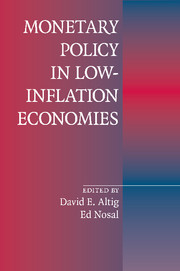Book contents
- Frontmatter
- Contents
- Contributors
- Acknowledgments
- Introduction
- 1 The Welfare Cost of Inflation in the Presence of Inside Money
- Commentary
- 2 An Open-Economy Model of Endogenous Price Flexibility
- Commentary
- 3 Efficient Inflation Targets for Distorted Dynamic Economies
- Commentary
- 4 Inflation and Welfare in Models with Trading Frictions
- Commentary
- 5 Good versus Bad Deflation: Lessons from the Gold Standard Era
- Commentary
- 6 Monetary Policy Orientation in Times of Low Inflation
- Commentary
- 7 Observations on Disinflation in Transition Economies
- Commentary
- 8 Inflation and Financial Market Performance: What Have We Learned in the Last Ten Years?
- Commentary
- Index
1 - The Welfare Cost of Inflation in the Presence of Inside Money
Published online by Cambridge University Press: 26 January 2010
- Frontmatter
- Contents
- Contributors
- Acknowledgments
- Introduction
- 1 The Welfare Cost of Inflation in the Presence of Inside Money
- Commentary
- 2 An Open-Economy Model of Endogenous Price Flexibility
- Commentary
- 3 Efficient Inflation Targets for Distorted Dynamic Economies
- Commentary
- 4 Inflation and Welfare in Models with Trading Frictions
- Commentary
- 5 Good versus Bad Deflation: Lessons from the Gold Standard Era
- Commentary
- 6 Monetary Policy Orientation in Times of Low Inflation
- Commentary
- 7 Observations on Disinflation in Transition Economies
- Commentary
- 8 Inflation and Financial Market Performance: What Have We Learned in the Last Ten Years?
- Commentary
- Index
Summary
In this paper, we ask what role an endogenous money multiplier plays in the estimated welfare cost of inflation. The model is a variant of that used by Freeman and Kydland (2000) with inside and outside money in the spirit of Freeman and Huffman (1991). Unlike models in which the money–output link comes from either sticky prices or fixed money holdings, here prices and output are assumed to be fully flexible. Consumption goods are purchased using either currency or bank deposits. Two transaction costs affect these decisions: One is the cost of acquiring money balances, which is necessary to determine the demand for money and to make the velocity of money endogenous. The other is a fixed cost associated with using deposits. This cost is instrumental in determining the division of money balances into currency and interest-bearing deposits. Faced with these two costs and factors that may vary over time in equilibrium (such as over the business cycle), households make decisions that, in the aggregate, determine the velocity of money and the money multiplier.
The model is consistent with several features of U.S. data: (1) M1 is positively correlated with real output; (2) the money multiplier and deposit-to-currency ratio are positively correlated with output; (3) the price level is negatively correlated with output in spite of conditions (1) and (2); (4) the correlation of M1 with contemporaneous prices is substantially weaker than the correlation of M1 with real output; (5) correlations among real variables are essentially unchanged under different monetary policy regimes; and (6) real money balances are smoother than money-demand equations would predict.
- Type
- Chapter
- Information
- Monetary Policy in Low-Inflation Economies , pp. 1 - 20Publisher: Cambridge University PressPrint publication year: 2009



